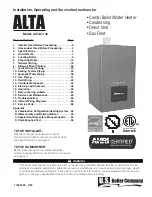
- 21 -
6.2. Installation of the ceramic parts into the combustion chamber
WARNING:
Only authorised service company trained by the manufacturer can install the ceramic
parts of the boiler into the combustion chamber. The initial installation of the
ceramic parts into the combustion chamber can be carried out exclusively by a
service company with valid authorization to service and commission the BENEKOV
boilers. The boiler user is authorized to install and dismantle the ceramic parts in the
combustion chamber as instructed by the service company only after the first
commissioning of the boiler and subsequent heating test.
It is forbidden to operate the boiler without the ceramics! Risk of thermal damage to
the boiler or fire!
BENEKOV K14 boiler (2 ceramic plates 230 x 160 x 25 mm):
•
Place the first plate vertically on the beam into the lower part of the combustion chamber so it
covers its rear wall.
•
Place the second plate vertically into the combustion chamber to cover its side wall (opposite
wall to the burner). Press this plate as far back as possible closely to the first plate and secure it
against falling.
BENEKOV K20 and K25 boilers (1 x ceramic f 1 x ceramic plate):
•
Place the ceramic fitting on the beams into the lower part of the combustion chamber to cover its side
wall.
•
Place the ceramic place vertically into the lower part of the combustion chamber to cover its rear wall.
The chamfer on this plate rests on the chamfer of the ceramic fitting.
6.3. Checks before commissioning the boiler
The following needs to be checked before the boiler is commissioned:
a) Filling the heating system with water
The water used to fill the boiler and the heating system must be clear and colourless, without any oil,
suspended or chemically aggressive substances.
Its hardness must be in accordance with ČSN 07 7401: 1992 and it is necessary that it is softened if its
hardness is not suitable.
Not even multiple boiling of the water with higher hardness prevents condensation of salts on the walls of
the heat exchanger. 1 mm thin layer of limestone condensation reduces the transfer of heat from the
metal to water by about 10% at the given location.
Heating systems with an open expansion tank allow direct contact of the heating water with the
atmosphere. In the heating season, the expanding water in the tank absorbs oxygen which increases the
corrosive effects and at the same time considerable amount of water evaporation occurs.
To replenish the water use
only water treated in accordance with ČSN 07 7401: 1992. The heating system
must be rinsed thoroughly to remove all impurities.
It is necessary to maintain constant volume of water in the heating system.
When replenishing the heating system with water care must be taken not to let air into the system. Water
from the boiler and the heating system must never be drained or taken out except when absolutely
necessary, i.e. during repairs, etc. By draining and re-filling the water risk of corrosion and scale formation
is increased.
Содержание K14
Страница 1: ...BOILER OPERATION AND INSTALLATION GUIDE BENEKOV K14 BENEKOV K20 BENEKOV K25 ...
Страница 9: ... 9 Fig 3 BENEKOV K14 boiler basic dimensions ...
Страница 10: ... 10 Fig 4 BENEKOV K20 and K25 boiler dimensions ...
Страница 17: ... 17 Fig 7 Position of the K14 boiler in a boiler room ...
Страница 33: ... 33 Fig 17 Diagram of electrical connection of XS20 burner of the K14 boiler ...
Страница 34: ... 34 Fig 18 Diagram of electrical connection of XS26 burner of the K20 and K25 boilers ...
















































